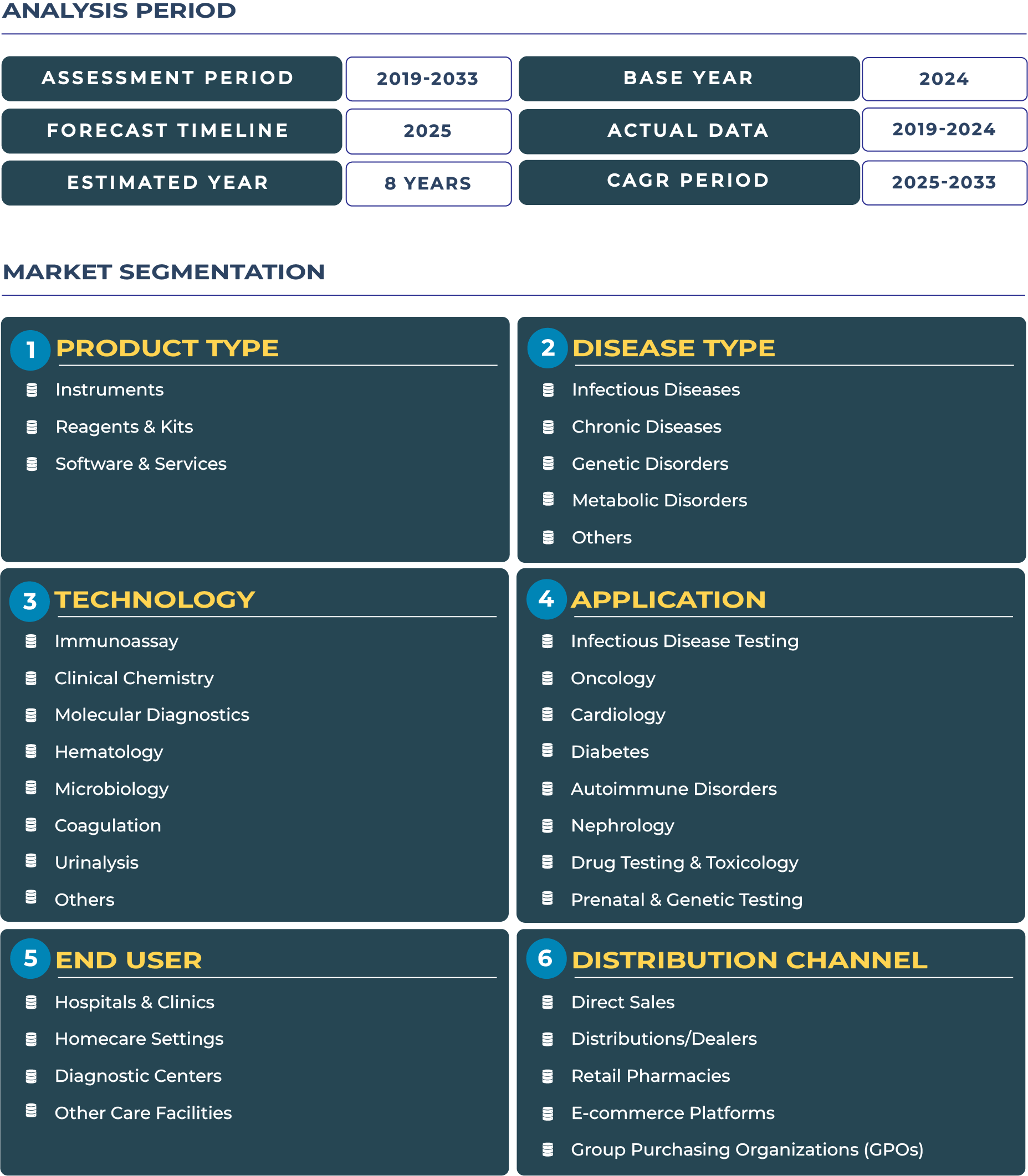South Korea’s MedTech Fusion: Digital Precision and Diagnostic Advancement in a Connected Healthcare Economy
South Korea’s healthcare transformation exemplifies the synergy between technology and medical science. Known for its innovation-led economy and strong orthopedics base, the nation has rapidly evolved into a MedTech powerhouse. Its hospitals integrate robotics, smart implants, and advanced imaging into clinical workflows, setting the tone for the next generation of diagnostic efficiency. This progressive ecosystem naturally complements the growth of the in-vitro diagnostic (IVD) market, which serves as the foundation of early disease detection and patient monitoring. As digital health, smart devices, and laboratory automation converge, South Korea’s IVD industry represents an exemplar of integration between precision diagnostics and high-tech medicine.
In financial terms, the South Korea in-vitro diagnostic market is expected to reach USD 2.12 billion in 2025 and expand to USD 3.50 billion by 2033, registering a CAGR of approximately 6.5%. This strong trajectory reflects the country’s ongoing investment in R&D, its advanced clinical infrastructure, and the acceleration of diagnostic innovation across molecular testing, immunochemistry, and AI-enabled diagnostic software. With robust support from the Ministry of Food and Drug Safety (MFDS), South Korea continues to enhance regulatory clarity and clinical validation pathways, enabling faster adoption of diagnostic technologies both domestically and internationally.
South Korea IVD Market Outlook: Smart Diagnostics in a Digitally Driven Clinical Environment
South Korea IVD market growth reflects the country’s strategic healthcare vision, bridging robotics, analytics, and molecular diagnostics to strengthen precision care. Hospitals in Seoul, Busan, and Daejeon are integrating automated analyzers and AI-driven diagnostic software that streamline workflows and optimize turnaround times. The government’s push for digital health infrastructure and laboratory automation aligns with its “Bio-Health Innovation Strategy,” promoting export-ready diagnostic solutions. Moreover, public-private collaboration under national innovation initiatives ensures that domestic manufacturers have access to research grants, biobank data, and advanced testing infrastructure. Despite being a mature, high-adoption market, rising chronic disease incidence, personalized medicine adoption, and growing health tourism sustain continued demand.
Drivers & Restraints: Technological Sophistication Amid Structural Challenges
Advanced Hospital Network, R&D Strength, and Tech-Driven Ecosystem Accelerate Growth
South Korea’s dense network of tertiary hospitals and research universities forms the core of its diagnostic ecosystem. Supported by world-class R&D capabilities, local companies continuously introduce high-precision instruments and reagents designed for both domestic use and global export. Major hospitals such as Seoul National University Hospital and Asan Medical Center have implemented molecular testing and genomics-based diagnostics integrated with real-time patient data systems. The IVD market benefits from the nation’s digital backbone, 5G-enabled healthcare platforms, robotics-assisted laboratories, and government funding for MedTech exports. Collectively, these factors make Korea a leader in the adoption of next-generation IVD systems across both hospital and outpatient settings.
Population Scale, Pricing Pressures, and Domestic OEM Competition Constrain Expansion
Despite its technological edge, South Korea faces limitations tied to market scale. With a relatively small population compared to neighboring economies, volume growth opportunities are modest. Additionally, strict price controls under the National Health Insurance Service (NHIS) limit the profitability of diagnostics, creating challenges for foreign entrants. The rise of local original equipment manufacturers (OEMs) has intensified competition, compressing margins in reagent and consumable categories. Regulatory updates, while supportive of innovation, also demand rigorous local validation, extending approval timelines. Consequently, international players must localize products, co-develop with Korean research partners, and adopt flexible pricing models to secure long-term presence.
Trends & Opportunities: From High-Tech Integration to Export-Ready Innovation
Trend: Smart Implant Integration, Medical Tourism, and Private Hospital Investments
South Korea’s private hospital sector is at the forefront of adopting smart diagnostic and orthopedic solutions. Integration of sensor-based implants with diagnostic platforms is expanding, enabling real-time monitoring of recovery metrics and infection markers. The nation’s reputation for affordable yet advanced medical care attracts global medical tourists, particularly from Southeast Asia and the Middle East, further increasing diagnostic testing volumes. Investments by private healthcare conglomerates into digital pathology, genetic testing, and robotics-assisted labs continue to redefine the diagnostic landscape. This convergence of technology and care delivery fosters a uniquely data-rich environment that enhances clinical accuracy and patient outcomes.
Opportunity: Co-Development Programs, Export Expansion, and Outcome-Driven Validation
South Korea IVD sector presents significant opportunities in co-development and export collaboration. Global manufacturers increasingly partner with Korean research centers to design region-specific diagnostic assays and modular software tools. These partnerships capitalize on Korea’s advanced semiconductor, biosensor, and data analytics expertise to produce export-ready diagnostics tailored for Asia and Europe. Moreover, the government’s trade promotion agencies actively support diagnostic exports through global certification alignment. Hospitals and suppliers also explore evidence-based procurement models emphasizing outcome measurement, longevity, and post-deployment analytics. Companies that combine diagnostic accuracy with digital reporting and remote data access stand to gain a durable competitive edge.
Competitive Landscape: Collaborative Models and Evidence-Based Differentiation
The competitive environment in South Korea in-vitro diagnostic market balances strong local manufacturing with active multinational participation. Companies like Seegene Inc., a pioneer in molecular diagnostics, have expanded their international footprint by launching multiplex PCR tests for infectious diseases and oncology. In 2024, Seegene strengthened its R&D collaborations with European laboratories to improve assay compatibility and throughput. Other key players, such as SD Biosensor, LG Chem Life Sciences, and foreign leaders like Roche Diagnostics and Abbott, operate through joint ventures and localized service models to meet Korea’s stringent performance standards.
Leading firms are pursuing strategies such as co-developing with local OEMs, sponsoring diagnostic excellence centers, and forming university-backed innovation hubs. By integrating long-term validation studies and establishing pilot programs in leading tertiary hospitals, diagnostic providers reinforce their clinical relevance and regulatory confidence. These partnerships are essential as the government continues to emphasize “clinical proof and export strength” as dual pillars of healthcare innovation.







